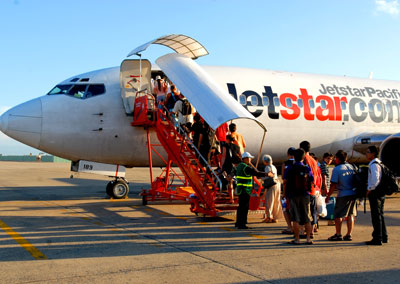
| Bye, bye, open sky? A bad week for Jetstar and Indochina Air | |
Jetstar Pacific has been accused of ignoring safety regulations. Indochina Airlines, deep in debt, faces loss of its license. This past week, says Nguoi Lao Dong, passengers were flocking back to Vietnam Airlines. At the dawn of a new ‘open skies’ era in Vietnam’s internal aviation market a scant three years ago, investors were queuing for licences. They saw aviation not only as a lucrative business, but also as an industry which could help put investors in a ‘higher class’ and make them giants. However, investors must meet strict requirements on business plans and technical requirements. In the end, only three new licenses were granted, though ten applications were made. Word went around that some investors were ready to pay many billions of dong to purchase an approved airline that only existed ‘on paper’.
Indochina Air on the ropes
Indochina Airlines was born in such conditions and began providing commercial flights in November 2008. It was not the first wholly private airline licensed in Vietnam, but it was the first private airline that provided flights. It also provides the first lesson about the competition in Vietnam’s aviation market
After just one year of operation, Indochina Airlines is heavily in debt. The airline has just cancelled all its flights until November 25 because there were too few passengers. Even the managers of Indochina Airlines now are not sure about the fate of the airline.
Some ask why Indochina Airlines has taken losses when the internal aviation market has been growing well, notwithstanding the economic downturn. Experts say that the growth rate of the transportation sector is double the nation’s overall growth rate. Only five million of Vietnam’s 86 million people have so far flown, so airlines still have plenty of ‘room’ to develop business.
Jetstar has its own troubles
Jetstar Pacific’s passenger totals have increased by 30 percent so far this year, while the seat occupancy rate of upstart Indochina Airlines has been very high at 80 percent. However, the receipts don’t cover expenses because the airlines have been engaged in competitive fare reductions. And, in that race, Vietnam Airlines has far deeper pockets than both Jetstar Pacific and Indochina Airlines.
Jetstar Pacific has become a serious contender to the ‘national flag carrier,’ Vietnam Airlines, since it increased the frequency of its Hanoi-HCM City service to 11 roundtrip flights per day and wrested nearly 50 percent of the high season passengers.
Six of Vietnam’s 32 domestic air routes are now competitive.
However, Jetstar Pacific has its own troubles. After relentless lobbying by Vietnam Airlines, the Civil Aviation Authority has ordered it not to use “Jet” and the orange star, so that passengers do not mistake it for the Australian air carrier that is a minority shareholder. Last week, moreover, when JP dismissed two foreign engineers, instead of going quietly, they publically accused the airline of cutting corners on aircraft maintenance.
Even with the financial backing of Qantas, Jetstar Pacific just managed to break even in July 2009. Its CEO and several other managers have resigned.
Rocked by these developments, some analysts are saying that Vietnam Airlines has already bested its rivals and can look forward to a future without significant competition on internal routes.
VietJet waits for the right moment
And yet, another contender is in the wings. VietJet Air has filed to begin providing commercial flights in May 2010, a time that analysts expect will be the beginning of a new boom period.
VietJet Air is capitalized at 600 billion dong. A leader of VietJet Air said that the airline has had to consider its flight plan very carefully, learning lessons from the hastiness of Indochina Airline and Jetstar Pacific.
Though it was the first private airline licensed in Vietnam, VietJet Air has twice postponed beginning service. The airline has reportedly spent 70 billion dong for the preparation work since it got its flying license. | |
| VietNamNet + NLD |
